

Writing Tip: “Touch it Once” Citations. Genealogical writing can be daunting.
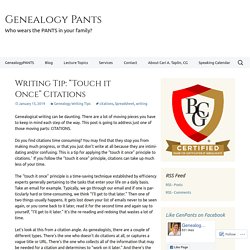
There are a lot of moving pieces you have to keep in mind each step of the way. This post is going to address just one of those moving parts: CITATIONS. Do you find citations time consuming? You may find that they stop you from making much progress, or that you just don’t write at all because they are intimidating and/or confusing. This is a tip for applying the “touch it once” principle to citations.1 If you follow the “touch it once” principle, citations can take up much less of your time. The “touch it once” principle is a time-saving technique established by efficiency experts generally pertaining to the tasks that enter your life on a daily basis. Let’s look at this from a citation angle. I’m not perfect. But my “touch it once” tip has one more step. My system utilizes a spreadsheet. As you can see from the screenshot, not every citation is in full EE style.2 This is because some of these I created back when I was a “baby genealogist.” 1.
Finding the Source of the Source on Ancestry. I am trying to create a source citation for a St.
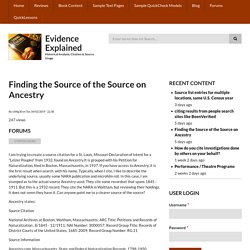
Louis, Missouri Declaration of Intent for a "Leizer Poupko" from 1932, found on Ancestry.It is grouped with his Petition for Naturalization, filed in Boston, Massachusetts, in 1937. If you have access to Ancestry, it is the first result when search with his name. Typically, when I cite, I like to describe the underlying source, usually some NARA publication and microfilm roll. In this case, I am stumped as to the actual source Ancestry used. They cite some recordset that spans 1845 - 1911. Website access mentioned in citations. Hi, I am trying to cite several newspaper articles in one footnote.

They came from different newspaper titles in different cities. Let's say I found all the the articles on the California Digital Newspaper Collection on the same date. I'm struggling with how to identify the access in the citation. It seems really long if I do "Fred Flintstone Elected Dinosaur Catcher," Bedrock Daily Slate (Bedrock, California), 17 March 1962, p. 6, col. 3; digital image, California Digital Newspaper Collection ( : accessed 20 March 2019). and then repeat the "digital image, California Digital Newspaper Collection ( : accessed 20 March 2019). for each of the next 3 articles all accessed on the same date from various papers on the CDNC site.
Should I do the first item like the full note, stopping each additional item after "...p. x, col. y. " and then have a separate sentence at the end of the note: Ten Citation Commandments for Intimidated Souls. Skip to main content QuickTips: The Blog @ Evidence Explained Ten Citation Commandments for Intimidated Souls 13 April 2014 The citation police are notorious.
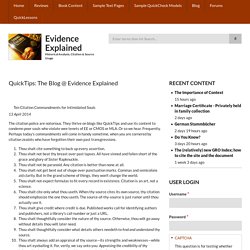
They thrive on blogs like QuickTips and use its content to condemn poor souls who violate wee tenets of EE or CMOS or MLA. QuickLesson 19: Layered Citations Work Like Layered Clothing. Citation with repeated information. I'm trying to cite a PDF reprint of a book that contains abstracts from a weekly newspaper.
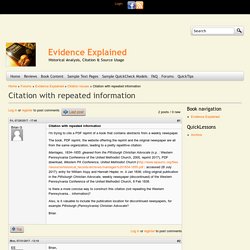
The book, PDF reprint, the website offerring the reprint and the original newspaper are all from the same organization, leading to a pretty repetitive citation: Marriages, 1834–1855: gleaned from the Pittsburgh Christian Advocate (n.p. : Western Pennsylvania Conference of the United Methodist Church, 2000, reprint 2017), PDF download, Western PA Conference, United Methodist Church ( : accessed 28 July 2017); entry for William Aspy and Hannah Hepler, m. 4 Jan 1838; citing original publication in the Pittsburgh Christian Advocate, weekly newspaper (discontinued) of the Western Pennsylvania Conference of the United Methodist Church, 8 Feb 1838.
Is there a more concise way to construct this citation (not repeating the Western Pennsylvania... information)? Also, is it valuable to include the publication location for discontinued newspapers, for example Pittsburgh (Pennsylvania) Christian Advocate? Brian. Citing of an Ancestry Member Tree. How do I cite the same source many times? Although ideally you will cite more than one source in your research paper, there are times when a single source dominates, and you find yourself referring to it or quoting it repeatedly.

Does that mean you have to cite that source in full in a footnote (or endnote) every time? Good news: you don’t! (Warning: some instructors might require you to cite in full every time, so be sure to ask before using any of these shortcuts.) Custodial History of Source as Evidence. Citing a photograph you personally took. An image citation how-to. Adding a citation to an image In honor of St.
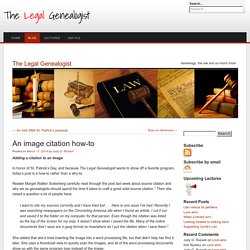
Patrick’s Day, and because The Legal Genealogist wants to show off a favorite program, today’s post is a how-to rather than a why-to. Reader Margel Walker Soderberg carefully read through the post last week about source citation and why we as genealogists should spend the time it takes to craft a good solid source citation. The Ancestry Insider: Artifact Citations. I came across a beautiful sampler on the Smithsonian’s website.
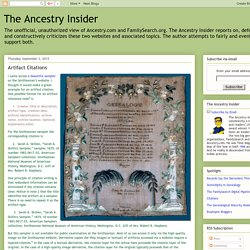
I thought it would make a great example for an artifact citation. One possible format for an artifact reference notea is 1. Creator, title or description, artifact type, creation date, archival identification; archive name, archive location. Optional explanatory notes. For the Smithsonian sampler the corresponding citation is.